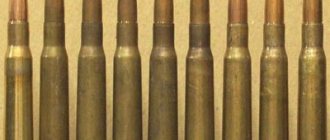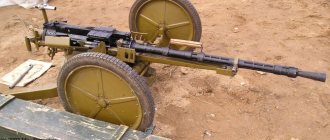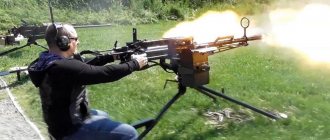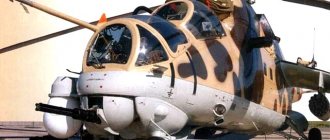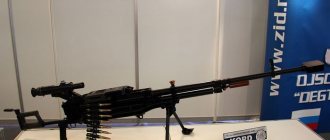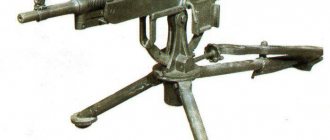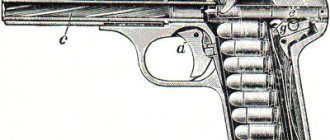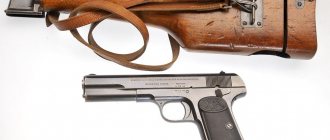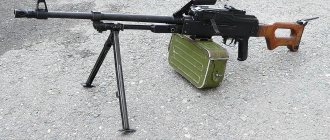The M2 or Browning .50 CaliberMachineGun is a heavy machine gun developed towards the end of World War I by John Browning. It was based on the earlier M1921, which used a 12.7x99mm cartridge developed from the geometry of the 13mm German anti-tank rifle cartridge.
In the process of developing the cartridge, the length of the cartridge case changed, the protruding welt was removed, which, although it made it easier to remove the cartridge from the chamber, at the same time made it difficult to design a weapon for this type of cartridge case.
The cartridge was adopted for service and received the official name - .50 caliber cartridge.
It was for this purpose that US heavy machine guns were developed. Despite its long service life, both the cartridge itself and the M2 machine gun remained the main heavy weapon of the American infantry for hundreds of years.
History of the development and development of the Browning M2 machine gun
The Browning M2 is a modified version of the M1921, which, in turn, was created on the basis of the M1917 and M1919 7.62 mm infantry machine guns. There were also modifications using 7.92 mm and less common “national” calibers of importing countries. The Browning M1921 was the first mass-produced heavy machine gun. It is noteworthy that US Army General Pershing personally insisted on using 12.7*99 mm ammunition (known abroad as .50BMG), because initially John Browning planned to use the French 11*59 mm cartridge.
The M2 itself was developed in 1932, and a year later it was put into service. Unlike its predecessor, the outdated water cooling was replaced with air cooling, the weighted barrel made it possible to significantly improve the rate of fire, and the modified design made it possible to use the machine gun in aviation.
Initially, the production of the M2 was carried out by the state-owned Rock Island Arsenal. With the entry of the United States into World War II, Colt's Patent Fire Arms Co, High Standard Co, Savage Arms Corp., Buffalo Arms Corp., as well as a number of other enterprises producing individual parts, also joined production. During the US participation in the war alone, about 2 million of these machine guns were produced, only a fifth of which (about 400 thousand) were intended for infantry.
This is what the shot looks like
In computer games
- Grand Theft Auto Vice City
- Operation Flashpoint
- Arma: Armed Assault
- Arma 2
- Arma 3
- Fallout Tactics
- Battlefield 1942
- Battlefield 2
- Battlefield: Bad Company 2
- Battlefield 3
- Battlefield 4
- Battlefield Hardline
- Left 4 Dead 2
- Call of Duty: United Offensive (At the beginning of the first mission, the player rides in a Willys jeep for the M2. In the fifth mission, the player flies in a B-17 Flying Fortress bomber armed with an M2)
- Call of Duty: World at War
- Half-Life
- Men of War
- NAM
- World of Warplanes
- War Thunder
- IL-2 Sturmovik
- Arma 2: Operation arrowhead
- Wargame: AirLand Battle
- Wargame: European Escalation
- Wargame: Red Dragon
- The suffering: Prison is hell
Structure of the structure and principle of operation
The automatic operation of the Browning machine gun is based on the principle of a short-stroke barrel recoil. Ammunition is supplied by an all-metal loose belt with closed links, and the direction of feed of the belt can be easily changed.
Browning machine gun parts and assemblies
The bore is locked thanks to a movable wedge stop moving in a vertical plane. After the shot, the bolt with the barrel moves back, then moves forward to lock the barrel channel and feed a new cartridge.
The Browning striker mechanism is equipped with its own shock spring and has the ability to fire both single shots and in automatic mode. The spring-type recoil absorber simultaneously serves as a return spring, and special grips placed on the shutter mirror serve to eject spent cartridges.
The M2 is equipped with a replaceable air-cooled barrel that screws into slots on the receiver. Unlike the previous model, the barrel is chrome-plated on the inside for greater durability and has a handle for easy replacement.
The standard version has only open sights: a front sight on the front of the receiver and a frame sight, but many different optical sights suitable for installation have been produced, including thermal imagers.
The range of machines is also pleasingly diverse; the machine under the designation M3 is especially popular among the troops.
With such a sight, a skilled shooter can easily hit a target at a distance of 1.5 kilometers
About small arms. 50 caliber
If you've never seen a .50 caliber rifle in person, get ready for a new experience. Both the size and weight of these products are amazing: on average, rifles weigh 12-15 kg with a total length of one and a half meters, and the diameters of the barrels and the dimensions of the muzzle devices evoke thoughts of small-caliber barrel artillery. The first association that comes to mind when seeing such a weapon is that it’s an anti-tank rifle! Indeed, PTRD and PTRS, adopted by the Soviet army in 1941, had an even larger caliber - 14.5x114 mm. Their mass was 17-20 kg with a total length of about two meters, but they were still considered light small arms. The difference between this formidable “anti-material”, as they now say, weapon of the last century and modern high-precision large-caliber sniper rifles lies completely different: the accuracy standards for anti-tank rifles during the war were a circle of 22 cm for four (or at least three) shots per distance of 100 m. This was considered normal, since the targets of these weapons were quite large - tanks, after all. And from the point of view of armor penetration, it no longer makes sense to shoot from a distance of more than 300 m.
For sniper systems, the standards for combat accuracy are almost an order of magnitude stricter: the complex must shoot no worse than one arc minute, that is, with the diameter of a group of five holes not exceeding 29 mm per 100 m. By the way, this is the same for high-precision 50-caliber rifles , which we are considering in this article, differ from modern incarnations of the idea of "anti-material weapons" - such as the notorious "Barretts".
About the legendary "Barrett"
When most people interested in weapons hear the words “50-caliber rifle,” they first think of the products of the American company Barrett Firearms, whose products under the designations M107 and M82 are in service with NATO forces and have already established themselves as a very formidable weapon. The prey of these rifles in war most often are unarmored and lightly armored vehicles, group targets, radars, missile systems and airfield-based aircraft, crews and maintenance of ATGMs, mortars, grenade launchers and artillery - in short, all those targets that do not require exceptionally high accuracy shooting. Because the accuracy of the Barretts is usually so-so: for the M82 and M107, a shooting accuracy of 2-3 MOA is considered normal. This is understandable, because one can hardly seriously expect outstanding results from a self-loading design with a floating barrel recoil mechanism. A completely different matter is .50-caliber rifles with manual reloading. The low rate of fire here is compensated by more acceptable weight and size indicators and - most importantly! – accuracy of match barrels and bolt groups of such weapons. It is thanks to the combination of high accuracy, range, power and relative mobility that the .50 BMG bolt-action rifles have occupied the niche of effective sniper and counter-sniper systems.
In the USA, where there were enough civilian shooters with .50 caliber to form their own Association, regular competitions are held in 1000-yard benchrest - that is, shooting from a fifty-dollar rifle for accuracy at a distance of 914 m. And you won’t see “self-loading” Barrett" in the list of winners' weapons. Not only because they are too expensive for the civilian market, but also because the accuracy is unsatisfactory for serious competition. Models with manual reloading are a completely different matter. So the “self-loading” one has the rate of fire, and leave the accuracy to the “bolt gun”.
McMillan TAC-50 A1R2 sniper complex with Nightforce BEAST 5-25×56 F1 scope and Hornady Match .50 BMG cartridges with A-Max bullet
Ammunition for M2
Over the long period of service, the “double M” acquired a huge assortment of ammunition. It is interesting to note that .50BMG (12.7x99 mm) stands for “Browning Machine Gun”. Due to the “M+Index” classification adopted by the American troops, confusion may arise, but it is important to understand that the presented list will focus specifically on 50-caliber cartridges.
So, dividing them by class and listing them in order of use:
- General purpose: M1923, M2, M3, M33;
- Armor-piercing: APM M1923, AP M2, AP M2 Alternate, AP M3, M903, M962;
- Tracers: TM 1923, M1 Tracer, M1 Tracer Alternate, M2 Tracer, M10, M17, M21;
- Armor-piercing incendiary: M8;
- Armor-piercing incendiary tracer: M20;
- Incendiary: M1, M1 Alternate, M23;
- Universal: MK 211.
The Alternate marking meant cheaper versions of ammunition due to the shortage of necessary metals during the war. Most of the list presented has been withdrawn from service in favor of more advanced models, but there is reason to believe that due to a certain conservatism of American generals, the old but reliable M2 will “survive” until the next generation of cartridges appears.
.50BMG cartridges (12.7x99 mm) and spent cartridges
Performance characteristics
Let's look at why half the world fell in love with this example of an “ageless” weapon:
| Weight | 38.22 kg |
| Weight with machine | 58.6 kg |
| Length | 1653 mm |
| Barrel length | 1143 mm |
| Rate of fire | 485-635 rounds per minute 750-850 rounds per minute (aviation modification AN/M2) 1200 rounds per minute (aviation modification AN/M3) |
| Initial bullet speed | 855-895 meters per second (depending on the ammunition used) |
| Sighting range | 1830 m |
As you can see, the main and, most likely, only drawback of the 12.7-mm Browning machine gun is its mass: not every soldier can handle hand-held shooting.
Use in combat
The 12.7 mm Browning M2 machine gun is one of the most powerful types of aircraft weapons in the game, provided that it is installed in quantities of 4-6 pieces.
Machine guns of other countries not only do not reach the M2 in power (except for the Soviet UB and the German 15-mm MG 151 cannon), but are also installed in much smaller quantities. It must be remembered that on fighter aircraft, M2 machine guns are usually mounted in the wings, and therefore the maximum density of fire is achieved only at aiming distance. Depending on your playstyle, the aiming point can be set at different distances - in principle, fire from the M2 is effective at a distance of up to a kilometer, although it shows the best results at a distance of 500 m or less. The choice of belt for machine guns also depends on your playstyle and preferred targets. When playing in Arcade battles, it is optimal to use a secret tape for fighters (allows you to confuse the enemy and not scare him off ahead of time) and a new tracer (with M20 BZT cartridges) for bombers. Ground tape is preferably used on ground vehicles, or also on bombers if the M20 cartridge is not available on your aircraft. When playing in Realistic and Simulation battles, a universal tape, or again a tracer with the BZT M20, performs very well.
The large ammunition capacity of the machine gun allows you to “draw” the route to the enemy aircraft using tracers, or open barrage fire with the expectation that the enemy himself will fly through a hail of bullets. The machine gun is also effective against light bunkers and light tanks (sometimes it is possible to destroy even medium tanks), but tanks should be attacked from behind or from the side, and light pillboxes should be attacked from the rear (from the side of the bunker exit).
When playing on ground vehicles, the M2 machine guns on the M13 MGC (2 machine guns) and M16 MGMC (4 machine guns) SPAA provide high density of fire when shooting at air targets and at the same time sufficient efficiency when shooting at early lightly armored tanks, especially from a short distance (up to 500 m) and when shooting from behind/from the side. A barrage of armor-piercing bullets “finds” vulnerable points in the armor and hits the crew, engine, ammunition rack, and fuel tanks.
Advantages and disadvantages
Advantages:
- Very high density of fire at the aiming point (for 4-12 machine guns).
- High lethality for a machine gun.
- As a rule, a large ammunition load.
- Possibility of use against lightly armored targets.
- High effective firing range for a machine gun.
Flaws:
- Large mass of installation of several machine guns.
- Insufficient lethality at high levels of play.
- Lack of effectiveness beyond the convergence point.
Methods of using a machine gun
It is still in service with the United States and NATO countries. In different countries it is used under the names: M2, M2HB, M2 Flexible, M2 Cal .50 and so on.
On tanks, lightly armored vehicles, some ships, as well as light boats during the Second World War, the M2 was used as a standard air defense weapon, while showing impressive results in shooting at ground targets.
But the real “finest hour” for the 50-caliber Browning was its use on airplanes. Almost every aircraft model necessarily had an M2, and the most notable in this regard was the P47 Thunderbolt fighter-attack aircraft, which carried eight such machine guns. Bomber aircraft often had eight-barrel batteries installed. But even this is not the limit: the standard armament of the B-17 included as many as 13 M2.
Also unusual is the use of the Browning M2 as a sniper weapon. The 12.7*99 mm bullet has excellent ballistics and is minimally exposed to wind. A particularly famous example comes from the Vietnam conflict: US Marine sniper Carlos Hascock often surprised his comrades by hitting opponents with an M2 with an Unertl sight from a distance of more than two thousand yards (1830 m). The record he set was a confirmed hit on a person from a distance of 2250 meters, and was broken only in 2002.
Interesting Facts
The image of the M1919 is actively used in the film industry; it appears in almost every film released in the USA about military operations during the Second World War. The most famous of them are “Saving Private Ryan”, “Fury” - where a young crew member fights with an M1919.
The machine gun also appears in most shooter games dedicated to combat operations in 1941-1945.
In the modern world, collecting deactivated weapons is widespread, but, unfortunately, purchasing an American machine gun in good condition, even if deactivated, will cost more than purchasing a hunting carbine of the Maxim system mod. 1910.
This machine gun was far ahead of its time. This is also evidenced by the fact that the machine gun remained in service with the USMC for a long time, albeit re-barreled with a less powerful cartridge. John Moses Browning was a brilliant gunsmith; almost all of his weapons, one way or another, were ahead of their time.
Popular modifications
First, you should pay attention to the licensed copies of Browning that are produced:
| Manufacturer country | Note |
| Belgium | Manufactured by FN Herstal. The M2HQCB modification was also developed there. |
| Great Britain | Manufactured by Manroy Engineering |
| Indonesia | Produced by Pindad under the name SMB-1 |
| South Korea | Manufactured under the designation K6 by S&T Dynamics |
| Finland | The M2 was produced during the Second World War under the name 12.7 Lkk/42 VKT |
| Switzerland | Manufactured by Astra Defense with the index MG127 |
Stylized postcard with a Browning M3 machine gun.
Adapted modifications were used in wartime aviation: AN/M2 and AN/M3. The main changes concerned a modified cartridge supply system (conventional belts were often unreliable in air combat conditions) and an improved rate of fire. Also, the Browning M3 machine gun later “grew up” into the GAU-21 and serves as an auxiliary weapon on helicopters, light aircraft and armored vehicles until the present day.
The already mentioned M2HQCB (Heavy Quick Change Barell - a heavy barrel with the ability to quickly replace) was developed by the Belgians in the 1970s.
Browning M2HB-QCB heavy machine gun (with quick-change barrel) on an M3 infantry machine
The main modification, as you might guess, was the barrel and the accompanying group of parts: the barrel cooling casing was changed, a barrel collar with a movable screw and a locking handle appeared. The rest of the M2 design is unchanged. A noteworthy fact is that the parts of the original Browning and M2HQCB are completely interchangeable, so Belgian gunsmiths produce components for old machine guns, and tools to “convert” them into standard models for European countries.
When developing the model, the Americans followed a similar path, albeit much later, and the M2A1 modification was adopted for service in 2010. The barrel will also undergo changes, making it possible to quickly replace it and additionally equipped with a flame arrester.
We are interested in the opinion of readers: is such a conservative approach justified in the US armed forces? Will Browning retire soon, and what should his descendant be like? Will we see the next step in the line of timeless classics? We are waiting for your comments.
Kaleidoscope of conflicts
At different times, the machine gun was used by different participants in conflicts. In some countries it is still in service, but in others it has already been written off and put into storage.
The Suez War (October 1957 – March 1957) was a war in Egypt that arose due to the uncertainty of the status of the Suez Canal. It was also called “Operation Kadesh”.
The Six Day War was a military confrontation in the Middle East that lasted from June 5 to 10, 1967.
Three Indochina wars, which, according to historians, were fought by European countries against Vietnam for maintaining influence over the Indochina colonies in the period from 1946 to 1991.
Military confrontation between Great Britain and Argentina for control of the Falkland Islands from April 2 to June 20, 1982.
South African War (or Namibian War of Independence), 1969 to 1989 - an armed clash on the territory of Namibia between the Organization of Independent Peoples of South-West Africa (SWAPO) with the support of the USSR, Angola and Zambia against South Africa and UNITA (rebels advocating the independence of Angola) with the support of the USA, China and Zaire.
The Gulf War is a large-scale confrontation between the armies of many countries led by the United States and Iraq for the independence of Kuwait. Even the USSR, which was on the verge of collapse, eventually supported the United States. The war lasted from August 2, 1990 to February 28, 1991.
Which started back in 1988 and continues to this day.
The US invasion of Grenada, known as Operation Urgent Fury, took place from October 25 to October 27, 1983.
Invasion of Panama - from December 20, 1989 to January 31, 1990. The official pretext was to protect the rights of US citizens and democratic values in Panama.
The Yugoslav Wars were a series of ethnic and religious conflicts between 1991 and 2001 that led to the collapse of Yugoslavia and the emergence of a number of independent republics. Considered the deadliest conflict since World War II.
US and NATO military operations in Afghanistan from 2001 to 2014. Considered the longest war in US history. Officially, the fighting aimed at confronting the Taliban ended in 2014, when the right to maintain order was transferred to local security forces. In fact, the fighting continues to this day.
Iraq war to overthrow the regime of Saddam Hussein 2003 – 2011.
The Mexican drug war is an armed conflict between Mexican drug lords and Mexican police that has lasted from 2006 to the present day.
The Cambodian Civil War was an armed confrontation between the local government, supported by the United States, and the Communist Party, which was supported by North Vietnam. The war lasted from 1967 to 1975.
Cambodian-Vietnamese War - from 1978 to 1991.
Colonial war in Portugal from 1961 to 1974. Also known as Guerra Colonial and Guerra do Ultramar.
Iran-Iraq War from 1980 to 1988.
